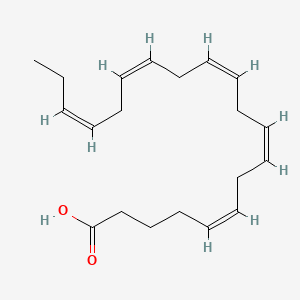| Danno K and Sugie N |
Combination therapy with low-dose etretinate and eicosapentaenoic acid for psoriasis vulgaris. |
1998 |
J. Dermatol. |
pmid:9863281
|
| Khalfoun B et al. |
Docosahexaenoic and eicosapentaenoic acids inhibit the CD28-lymphocyte activation pathway in vitro. |
1998 |
Transplant. Proc. |
pmid:9865267
|
| Meng CL et al. |
Inhibition of the synthesis of eicosanoid-like substances in a human oral cancer cell line by interferon-gamma and eicosapentaenoic acid. |
1998 |
Arch. Oral Biol. |
pmid:9877329
|
| Marzo I et al. |
Loss of delta6-desaturase activity leads to impaired docosahexaenoic acid synthesis in Y-79 retinoblastoma cells. |
1998 |
Prostaglandins Leukot. Essent. Fatty Acids |
pmid:9888202
|
| Brown AM et al. |
Administration of n-3 fatty acids in the diets of rats or directly to hepatocyte cultures results in different effects on hepatocellular ApoB metabolism and secretion. |
1999 |
Arterioscler. Thromb. Vasc. Biol. |
pmid:9888872
|
| Terano T et al. |
Eicosapentaenoic acid and docosahexaenoic acid inhibit vascular smooth muscle cell proliferation by inhibiting phosphorylation of Cdk2-cyclinE complex. |
1999 |
Biochem. Biophys. Res. Commun. |
pmid:9918868
|
| Nourooz-Zadeh J et al. |
F4-isoprostanes as specific marker of docosahexaenoic acid peroxidation in Alzheimer's disease. |
1999 |
J. Neurochem. |
pmid:9930747
|
| Knight J et al. |
Eicosanoid biosynthesis in an advanced deuterostomate invertebrate, the sea squirt (Ciona intestinalis). |
1999 |
Biochim. Biophys. Acta |
pmid:9989276
|
| Kajikawa H |
[The influence of dietary lipids on nephrolithiasis in rats]. |
1998 |
Nippon Hinyokika Gakkai Zasshi |
pmid:9990224
|
| Alexander JW |
Influence of EPA and DHA intravenous fat emulsions on nitrogen retention and protein kinetics in burned rats. |
1999 |
Nutrition |
pmid:9990585
|
